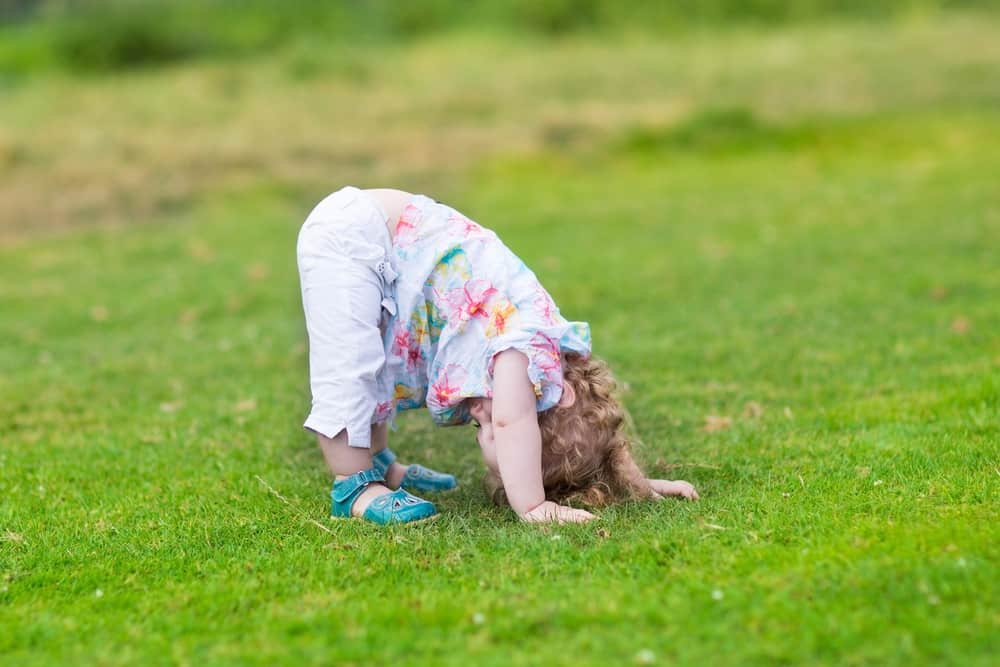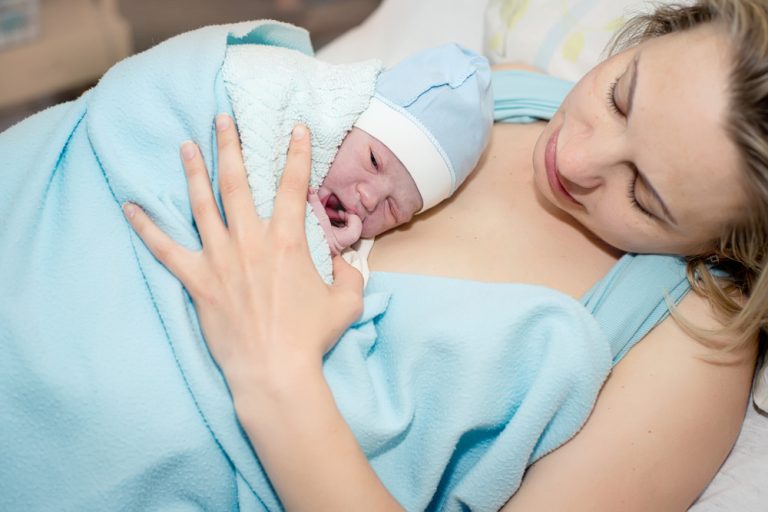At around 14 to 16 months old, your baby might start channeling their inner yogi with a forward fold or downward dog. While their flexibility is impressive, it might leave you wondering… What does it mean when babies stand on their heads? Is it safe? And should mom be peeing on a stick?
Why Does Your Baby Stand on Their Head and Look Between Their Legs?
Here are the reasons why your baby keeps folding over to have a peek through their chubby thighs:
They’re Exploring New Perspectives
Your baby’s world looks very different from an upside-down perspective. After discovering it, it’s no wonder they’re taking some time to inspect the new view.
Feeling Dizzy Is Funny
Standing on their head could give your little one a funny, dizzy feeling. Some kids can’t stand it, but others live for it. If your tot likes it when you spin them around, they’ll probably love hanging out upside-down too.
They’re Hitting a New Developmental Milestone
Usually, between 14 and 16 months old, your baby will gain the ability to stand on their head. Like when they hit their other milestones, they’ll love trying out their new skill.
However, just like rolling over or pulling up to stand, they’ll soon replace it with their next new move. So, soak it in and make sure you get a few pictures.
They Love Attention
If your baby’s first time standing on their head earned them a laugh, a photo, or excitement, they’ll want to do it again and again.
They are as impressed by a new reaction from you as you are by one from them. That’s why pulling funny faces or breaking out new dance moves is always good for prompting a baby giggle.
They’re Looking Behind Them
A very simple explanation for why your baby is standing on their head is that they want to look behind them. Of course, there are easier ways to achieve this. But since when do babies choose the easy way?
They’re Working On Their Gross Motor Skills
Bending over to stand on their heads takes a lot of muscle strength and control. Their weird new pose might look funny, but it’s actually a great core workout. And we all look a little strange when working out!
A daily dose of looking under their legs will strengthen the muscles that improve their posture and balance. Not bad, maybe we should join them.
They’re Stimulating Their Vestibular System
The vestibular system is responsible for helping us balance and orient ourselves. By playing with their orientation, your baby is stimulating this system. This supports brain development and helps develop sensory connections.
Studies have even shown that higher rates of vestibular stimulation in early life lead to increased cognitive performance. Of course, walking, balancing, and spinning will all do the same job. So, don’t panic if your tot stops hanging out upside down.
They’re Enjoying the Stretch
There’s nothing like a bit of yoga for a nice stretch. It could be that your baby has just discovered that a nice forward fold or downward dog feels great.
It Chills Them Out
If your baby keeps bending over when they’re tired, anxious, or upset, it could be that the position helps them feel calm. Some babies find being upside down to be a great stress reliever.
The position might not look relaxing to adults, but it wasn’t long ago that your little one was chilling upside-down in the womb. Add in the sensory stimulation, and you’ve got a great toddler stress reliever.
They’re Playing Copycat
Babies are copycats. It’s how they learn new skills and what their little bodies are capable of. If your little one has spotted other kids standing on their heads, they’ll want to join in too.
They’re Looking for a Sibling
There’s an old wives’ tale that says your baby can sense that their mom is pregnant. They’ll show they know by looking between their legs as if they’re looking for a sibling.
It might sound crazy, but thousands of moms today will swear their kid predicted a sibling this way. Plus, babies are great at picking up on their parent’s emotions.
However, there’s another explanation. As we know, tots usually hit this milestone at around 14 to 16 months old. This also happens to be a very popular age for moms to start trying for a second or third baby. So, it could be a coincidence after all.
There’s a Medical Issue
Baby headstands aren’t a red flag for any specific medical condition. If your baby seems happy doing them, there’s almost certainly no problem.
However, always check with a medical professional if your baby seems in pain or distress. They might have an injury or condition that feels better when they bend over.
The pose will also give you an excellent opportunity to check their spine. It should follow a smooth curve as they bend. If you notice any strange bumps or irregularities, you should have them checked out.
Is it Safe For A Baby to Stand On Their Head?
Yes, it’s totally safe for your baby to stand on their head for short periods. Even if they do it frequently throughout the day.
However, it can make them feel dizzy and could affect their balance. So, falls and bumps are possible.
What Should You Do if Your Baby Keeps Standing on Their Head?
Protect your little yogi by:
- Moving hard objects away from them.
- Surrounding them with pillows or foam mats.
- Being ready to catch your dizzy tot.
- Stopping them from pulling the pose on raised surfaces, like a couch or bed.
If you think they need a break, distract them or find another way to provide sensory stimulation.
How to Stimulate a Baby’s Vestibular System
Some of the best play activities double as fantastic vestibular stimulation exercises. Try these out if your baby craves rocking, bouncing, spinning, or standing on their head:
- Riding a rocking horse
- Swinging on a swing
- Rocking in a rocking chair
- Swaying in a hammock
- Jumping on a baby trampoline
- Bouncing on a ball
- Tumbling on a crash mat with activities like supported forward rolls
- Spinning on toys like a sit’n’spin
- Swimming
- Dancing
- Riding on ride-along toys like cars or trikes
So, there you have it. A little tush in the air is nothing to worry about. Your baby Einstein is probably just exploring their place in the world, stimulating their brain, and strengthening their body. Or, they just find it funny! It’s all good.




